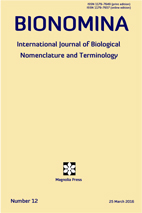Abstract
Photography has, since its inception, significantly contributed as a tool to many areas of scientific research and consequently, has been able to achieve a high level of prestige in the scientific field. In recent years, there has been an increasing debate within the scientific community regarding the need for the deposition of type specimens when describing new species. Recently, Marshall & Evenhuis (2015) described a new species of Diptera, based exclusively on a few photographs. Even if one withholds judgement about whether the photographs used present sufficient characteristics for the description and identification of this new species, data missing from the holotype photograph could be of great importance for other analyses and future comparisons. The authors have omitted the digital photographic format used for the photographs in their work, and at no point has a deposition of the RAW type (a digital format sometimes called digital negatives, this file preserves most of the information from the captured picture) for verification of its authenticity been mentioned. The absence of this file for verification of the authenticity of the photograph makes its scientific credibility questionable and untrustworthy. We consider this taxonomical practice based exclusively on the use of photographs to be simplistic and harmful. Although the Code does not mention Rules about the use of photography formats we strongly suggest that, for the elaboration of academic articles, not only in taxonomic ones, using characteristics based on digital photography, the authors should be willing to make the RAW file of the photograph available for comparison in order to avoid doubts regarding the authenticity of the photograph presented.
References
Anonymous [International Commission on Zoological Nomenclature] (1999) International code of zoological nomenclature. Fourth edition. London (International Trust for zoological Nomenclature): i–xxix + 1–306.
Dubois, A. & Nemésio, A. (2007) Does nomenclatural availability of nomina of new species or subspecies require the deposition of vouchers in collections? Zootaxa, 1409: 1–22.
Jones, T., Ehardt, C. L., Butynski, T. M., Davenport, T. R. B., Mpunga, N. E., Machaga, S. J. & DeLuca, D. W. (2005) The highland mangabey Lophocebus kipunji: a new species of African monkey. Science, 308: 1161–1164. <http://dx.doi.org/10.1126/science.1109191>.
Krell, F. T. & Wheeler, Q. D. (2014) Specimen collection: plan for the future. Science, 344: 815–816. <http://dx.doi.org/10.1126/science.344.6186.815>.
Marshall, S. A., & Evenhuis, N. L. (2015) New species without dead bodies: a case for photo-based descriptions, illustrated by a striking new species of Marleyimyia Hesse (Diptera, Bombyliidae) from South Africa. Zookeys, 525: 117–127. <http://dx.doi.org/10.3897/zookeys.525.6143>.
Minteer, B. A., Collins, J. P., Love, E. E. & Puschendorf, R. (2014) Avoiding (re)extinction. Science, 344: 260–261. <http://dx.doi.org/10.1126/science.1250953>.
Santos, C. M. D., Amorim, D. S., Kassa, B., Fachin, D. A., Nihei, S., Carvalho, C. J. B., Falaschi, R. L., Mello-Patiu, C., Couri, M., Oliveira, S. S., Silva, V. C., Ribeiro, G. C., Capellari, R. S. & Lamas, C. J. E. (2016) On typeless species and the perils of fast taxonomy. Systematic Entomology, 41 (3): 511–515. <https://doi.org/10.1111/syen.12180>.
Silva, W. S. (2015) O Estatuto documental da fotografia na era digital. Artciencia.com, 19: 1–10.
Smith, E. F. G., Arctander, P., Fjeldså, J. & Amir, O. G. (1991) A new species of strike (Laniidae: Laniarius) from Somalia, verified by DNA sequence from the only known individual. Ibis, 133: 227–235. <http://dx.doi.org/10.1111/j.1474-919x.1991.tb04564.x>.
Wilder, K. (2009) Photography and science. London (Reaktion Books): 1–144.

